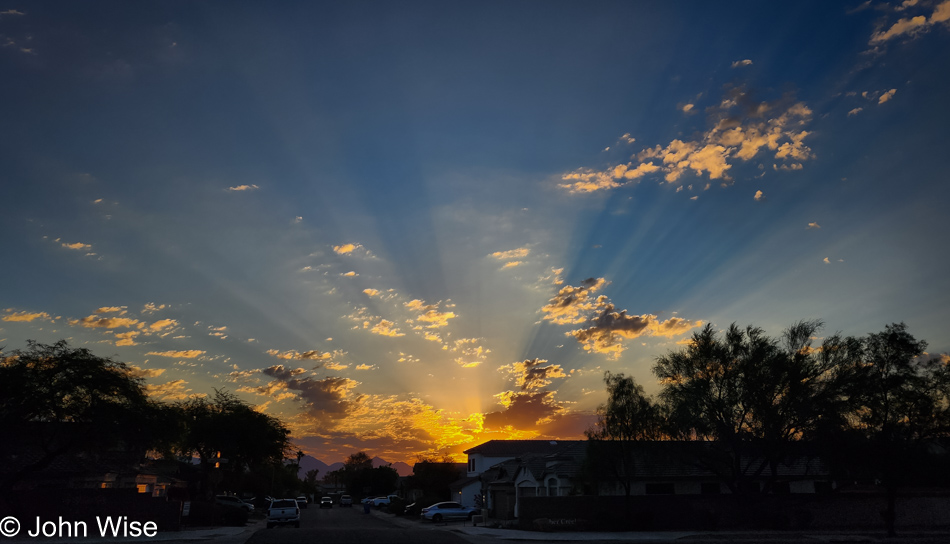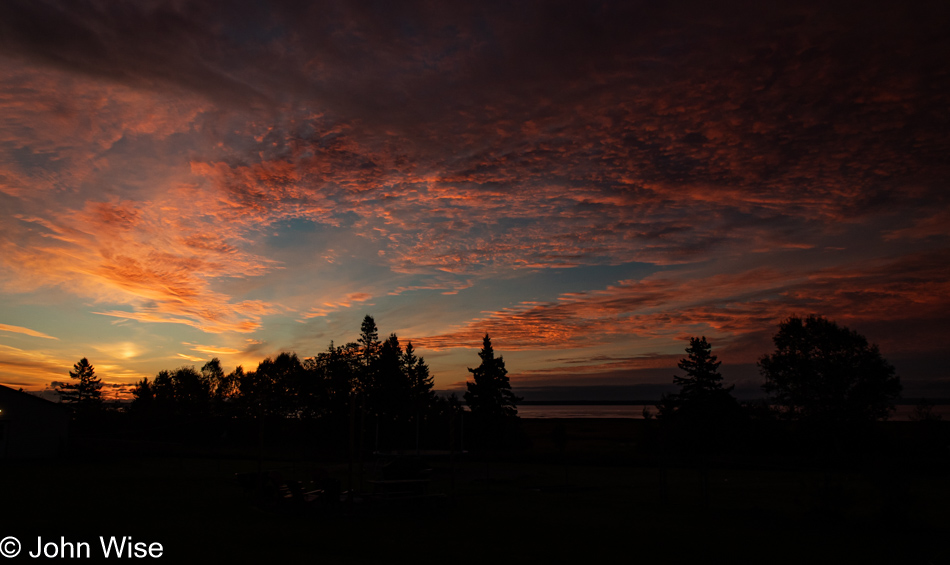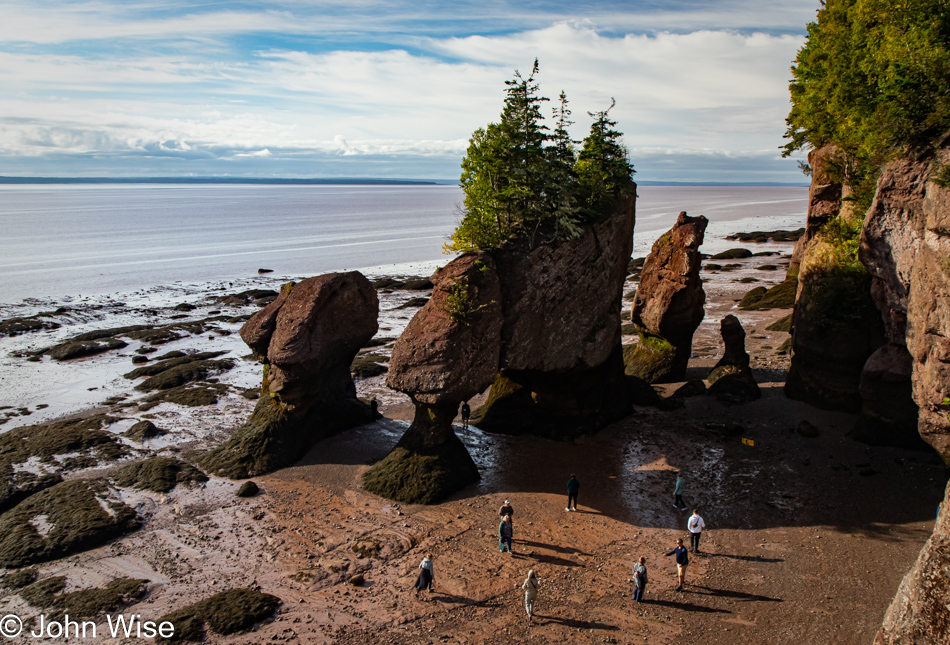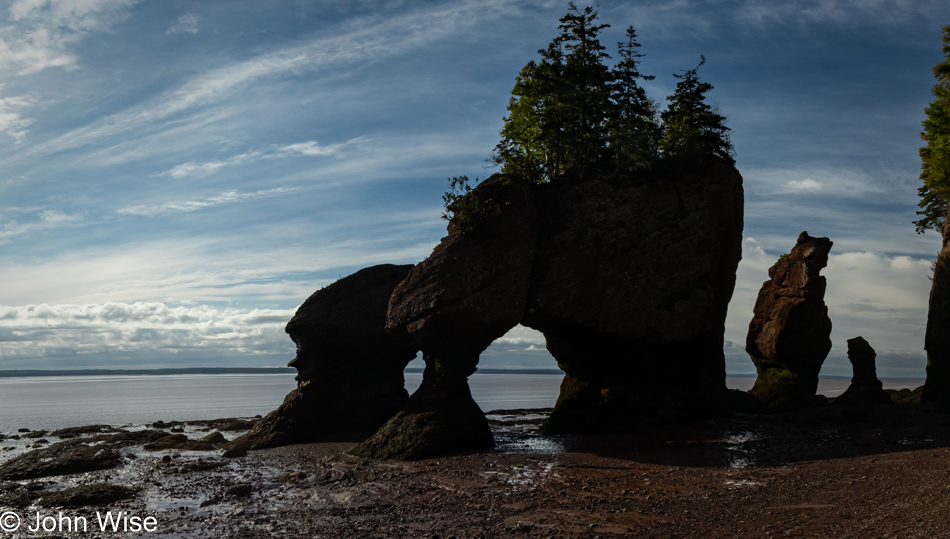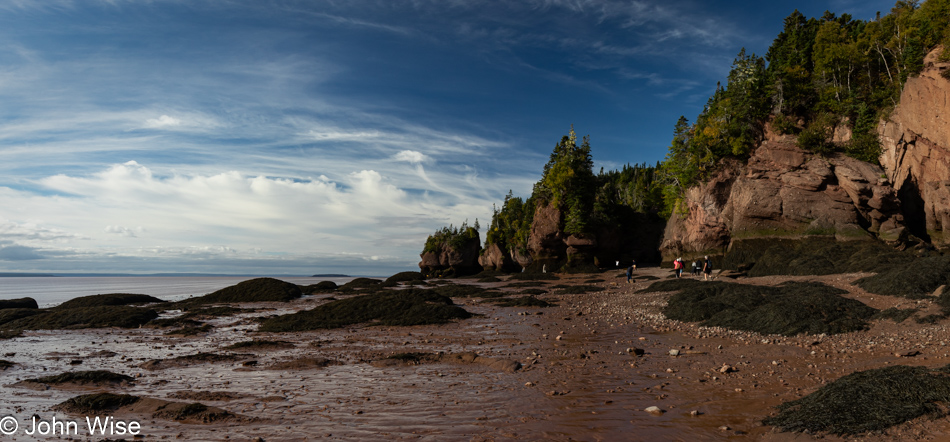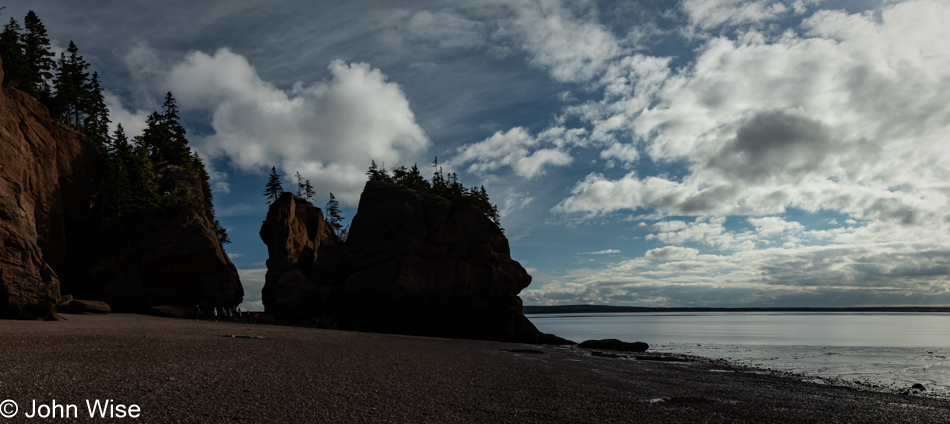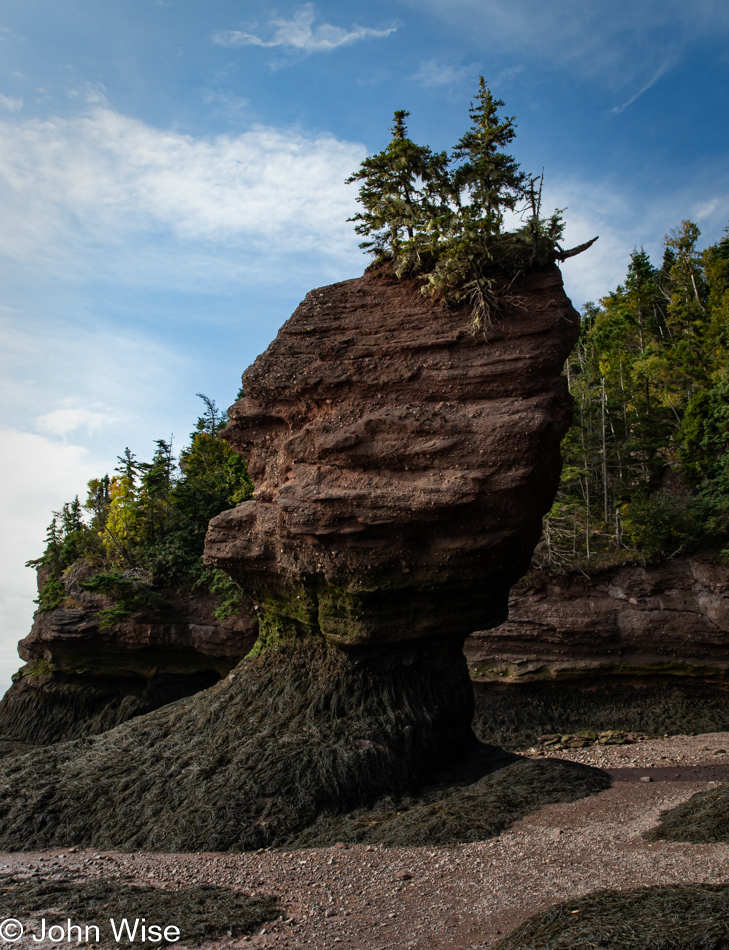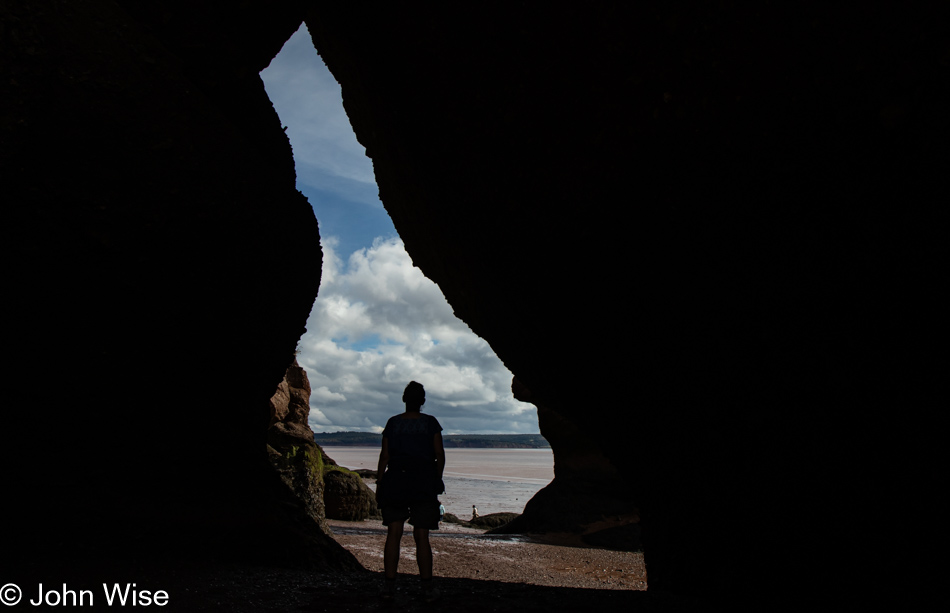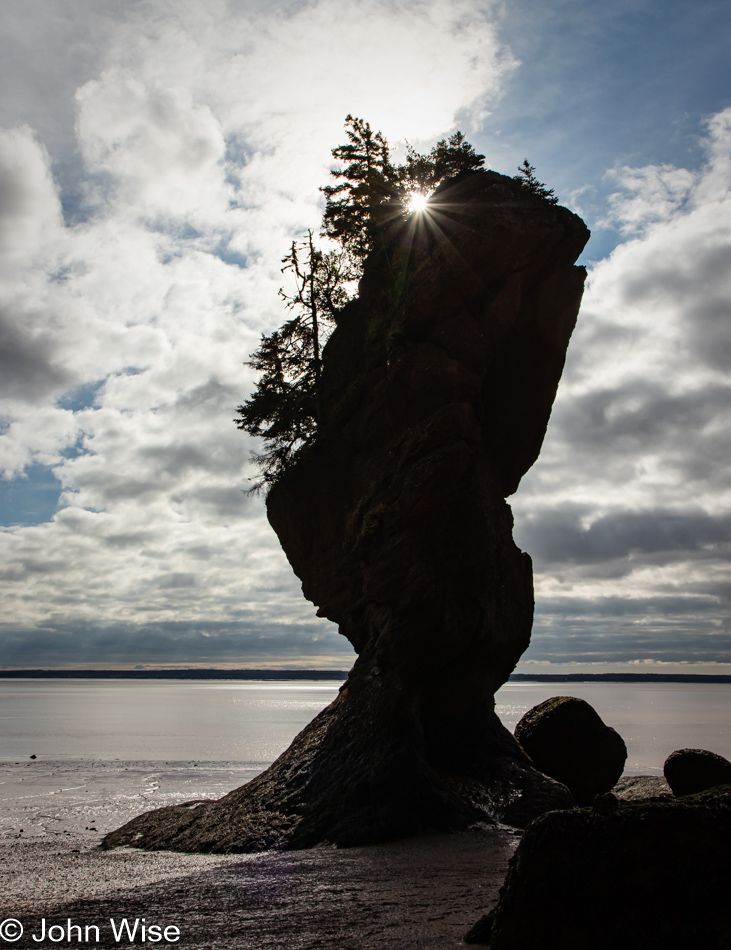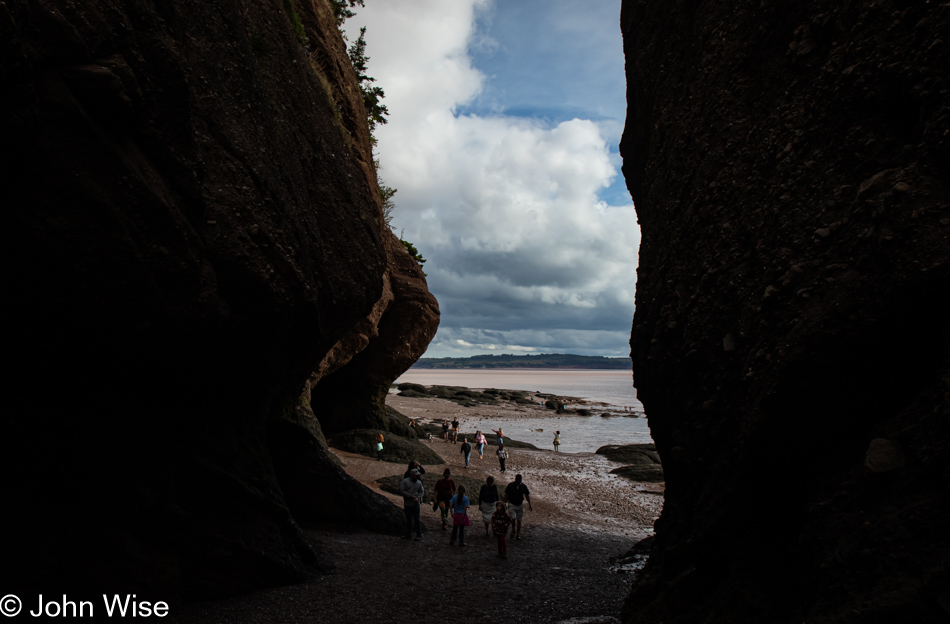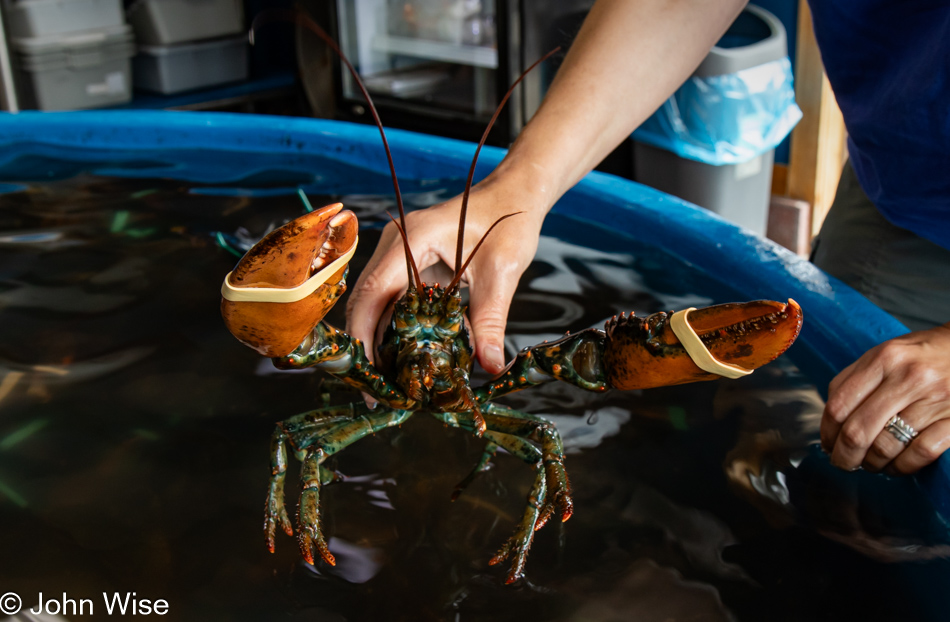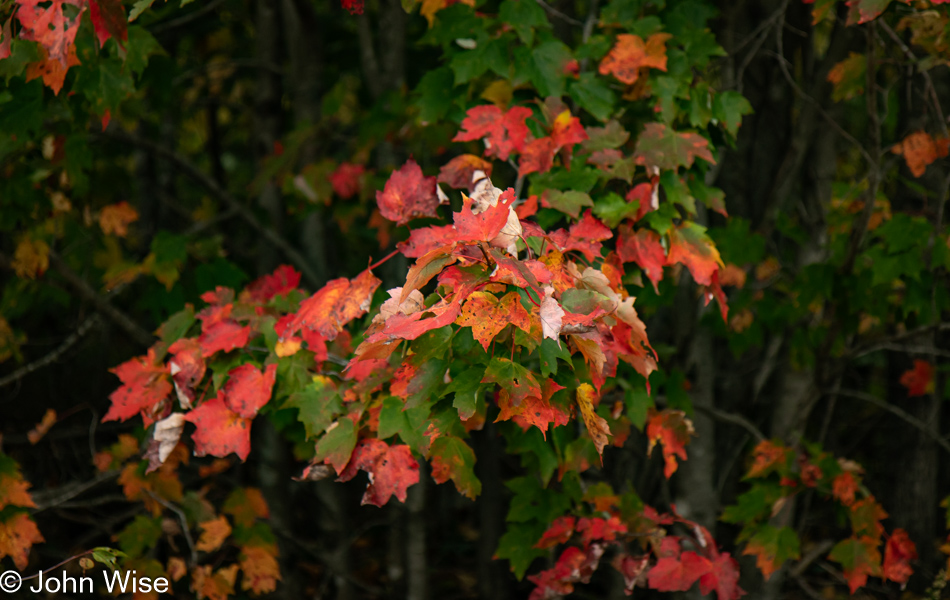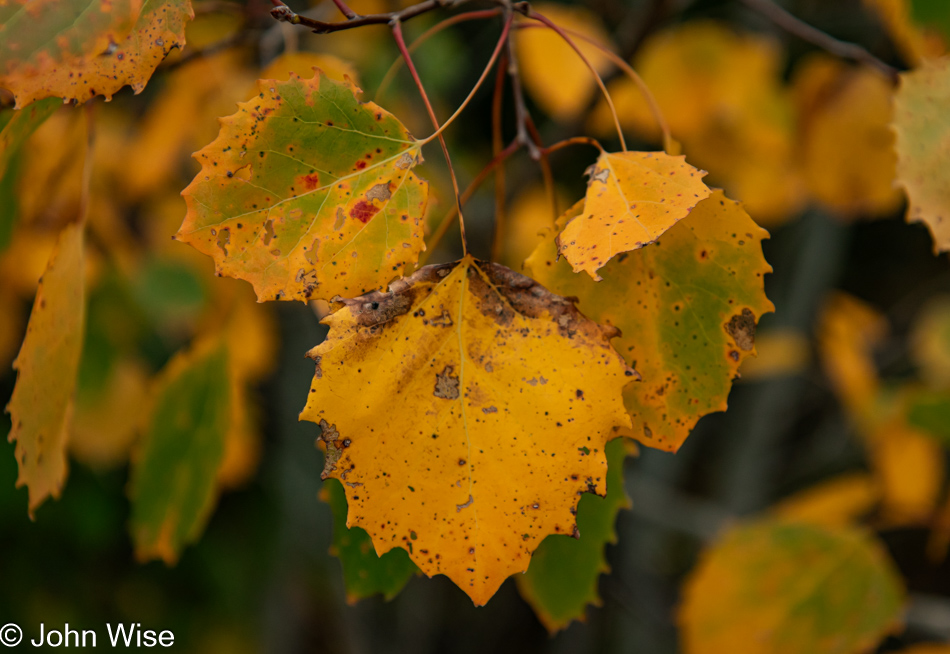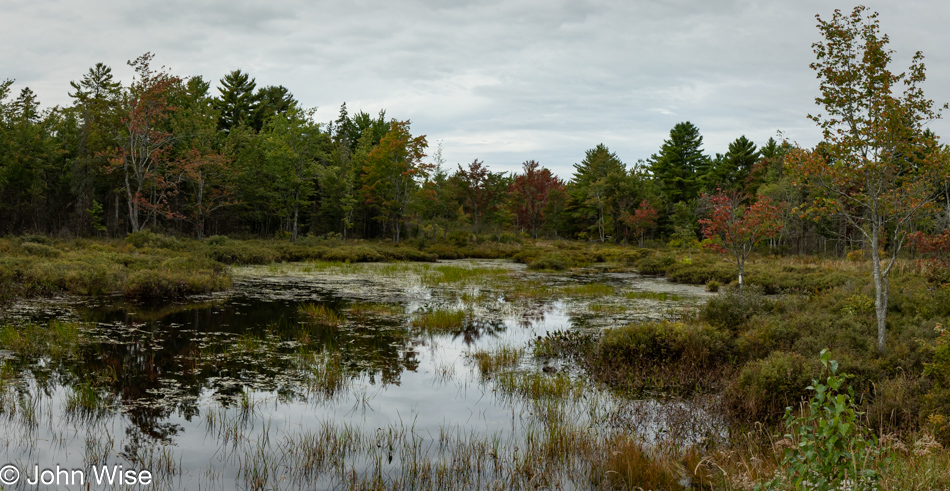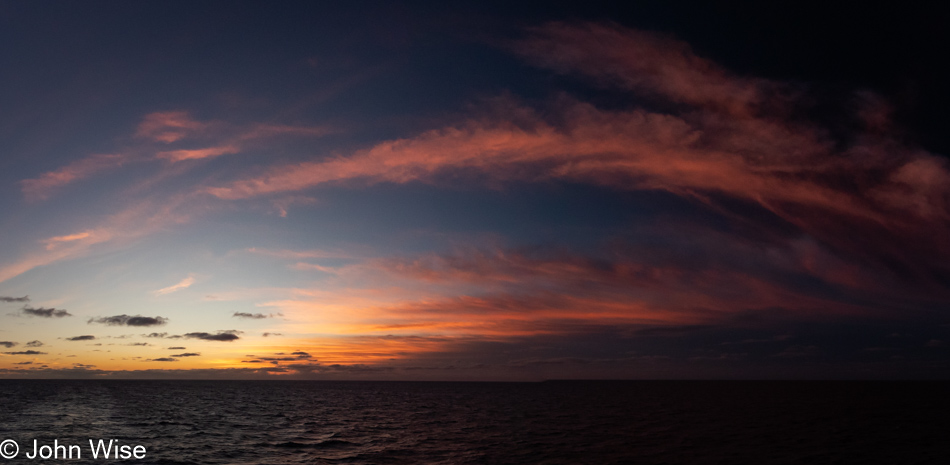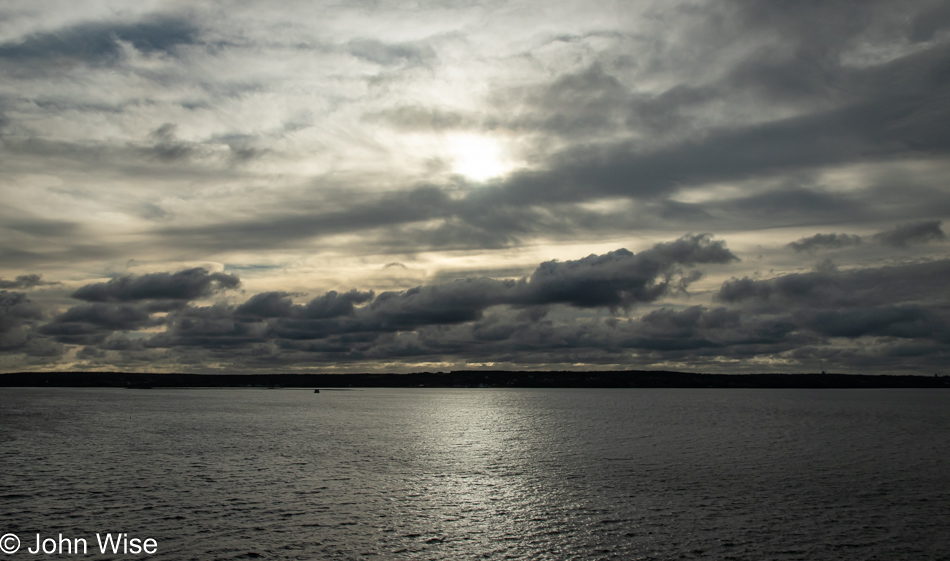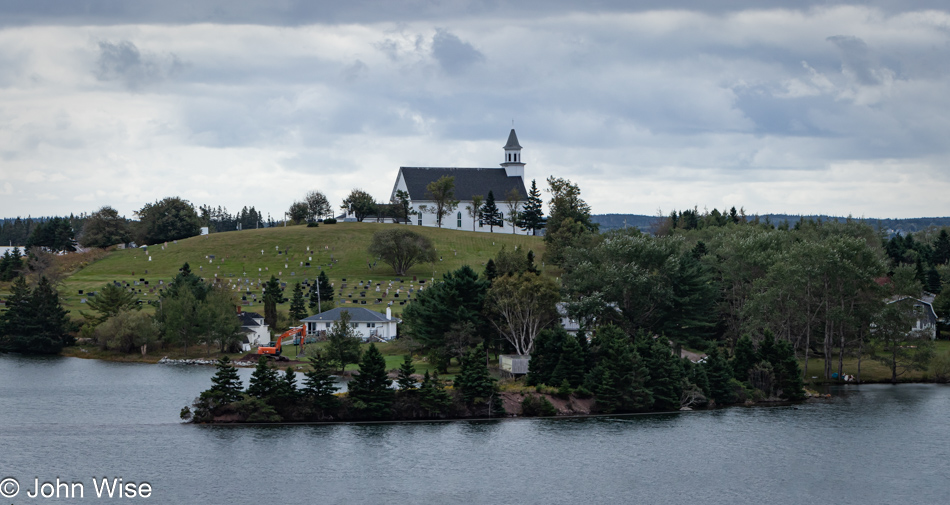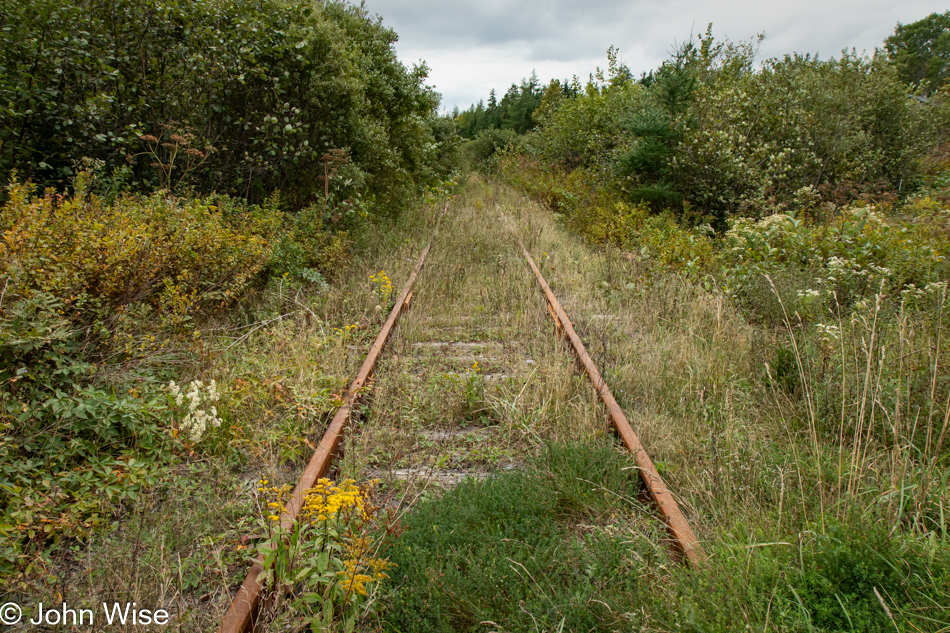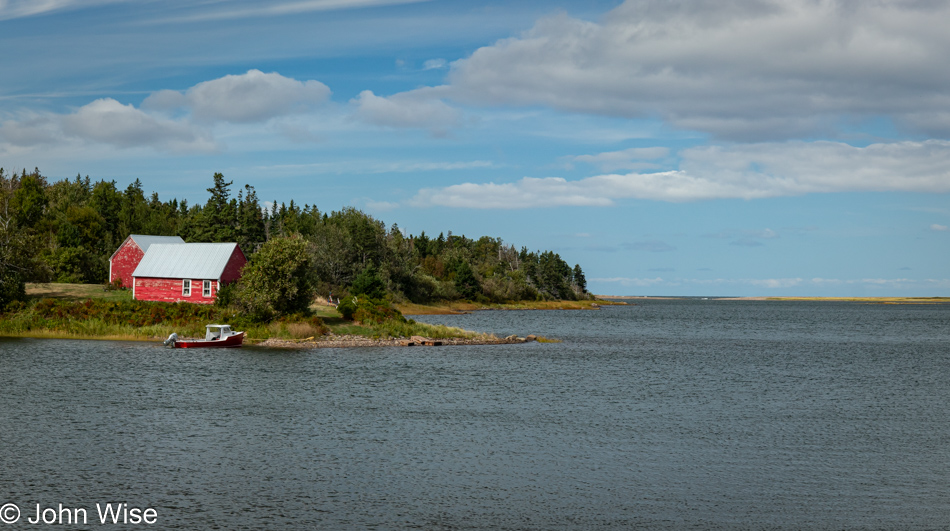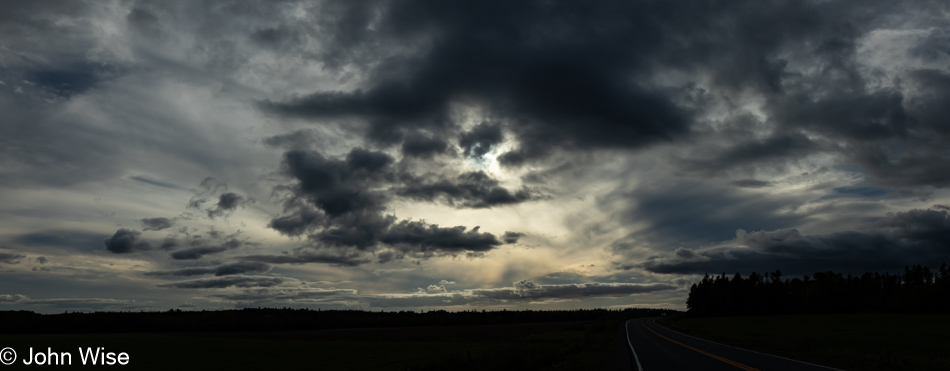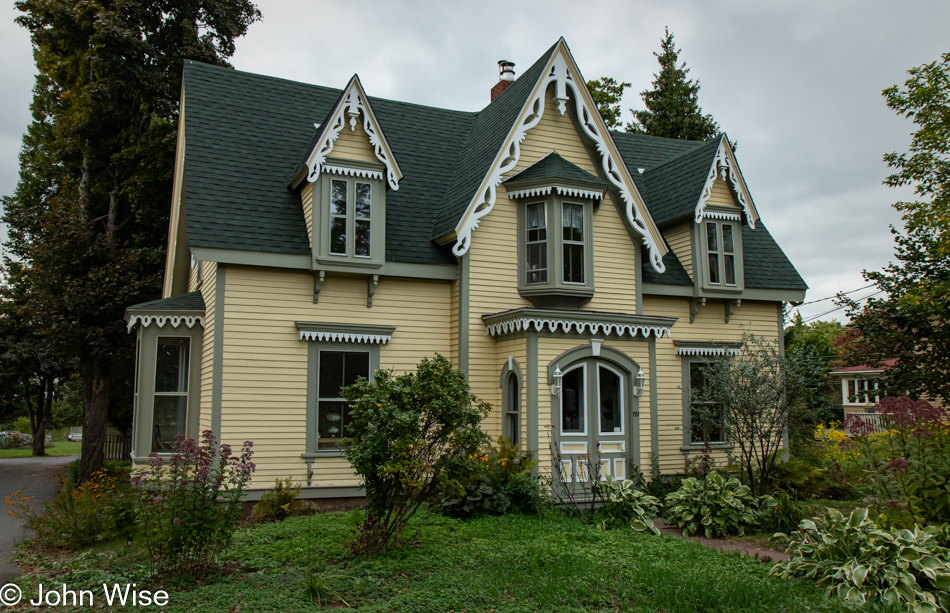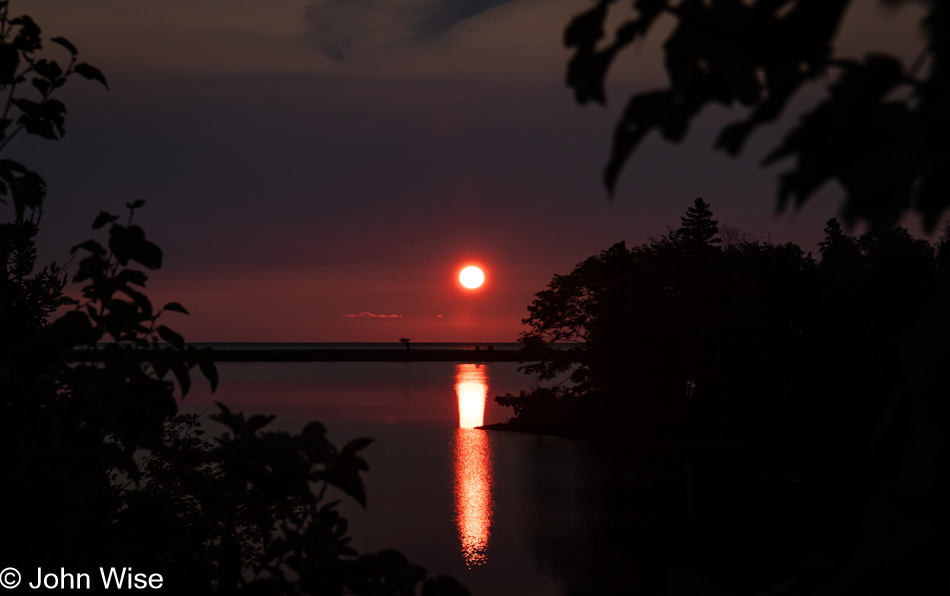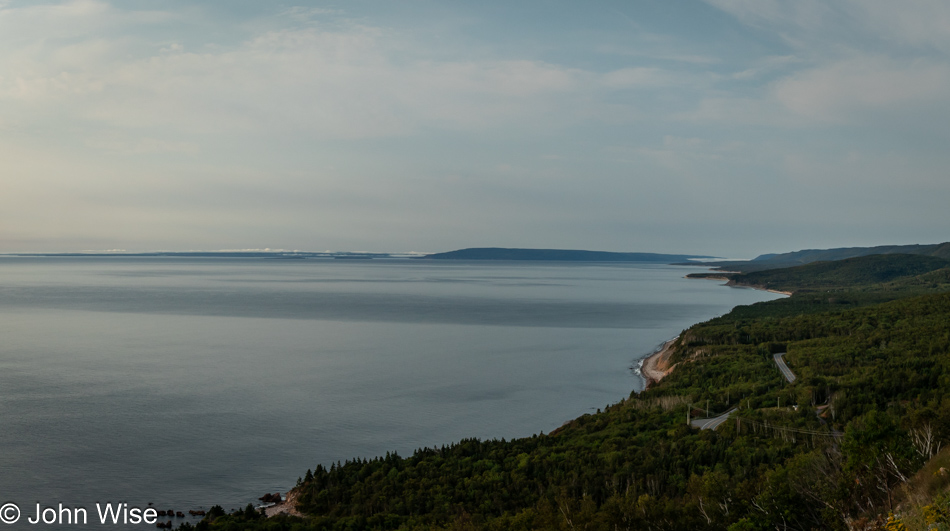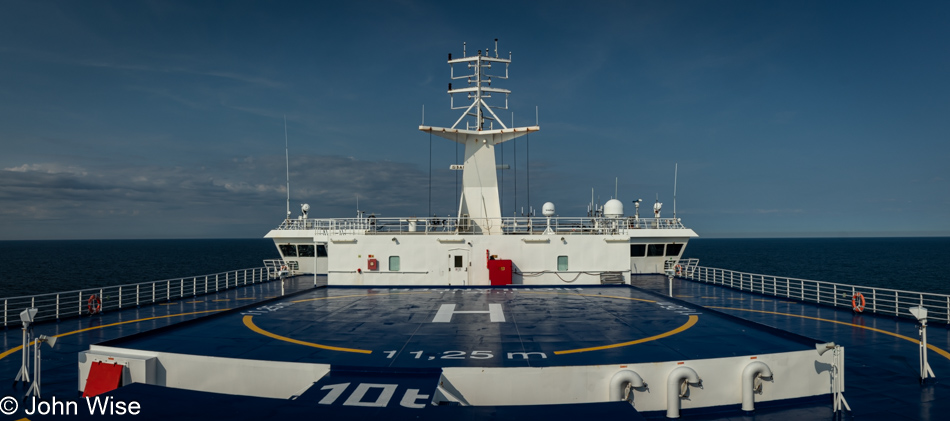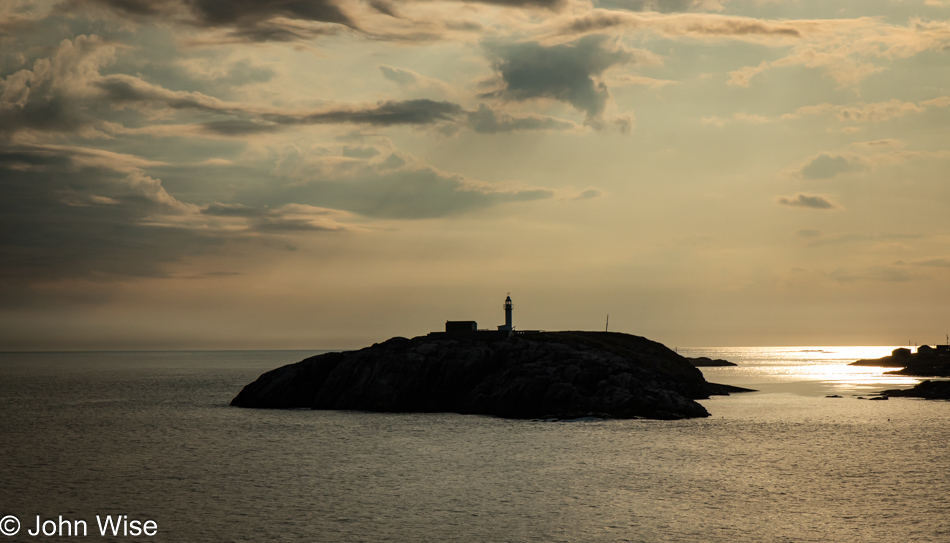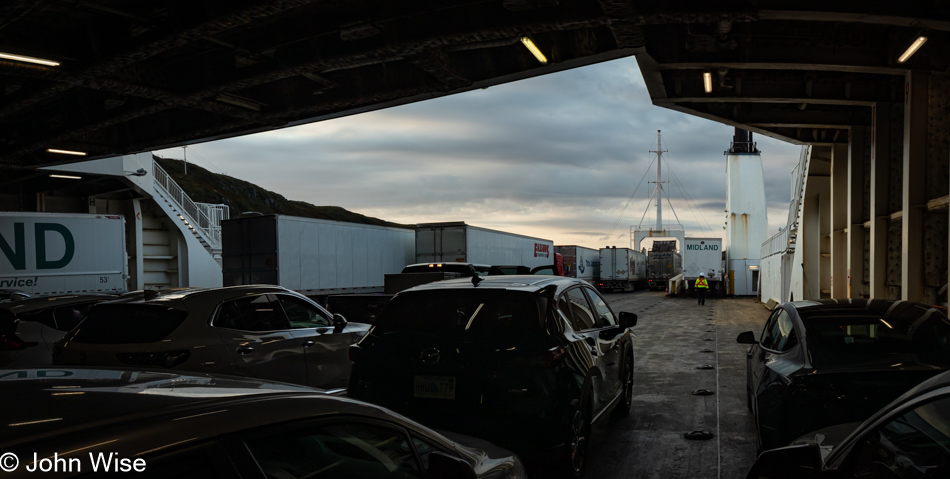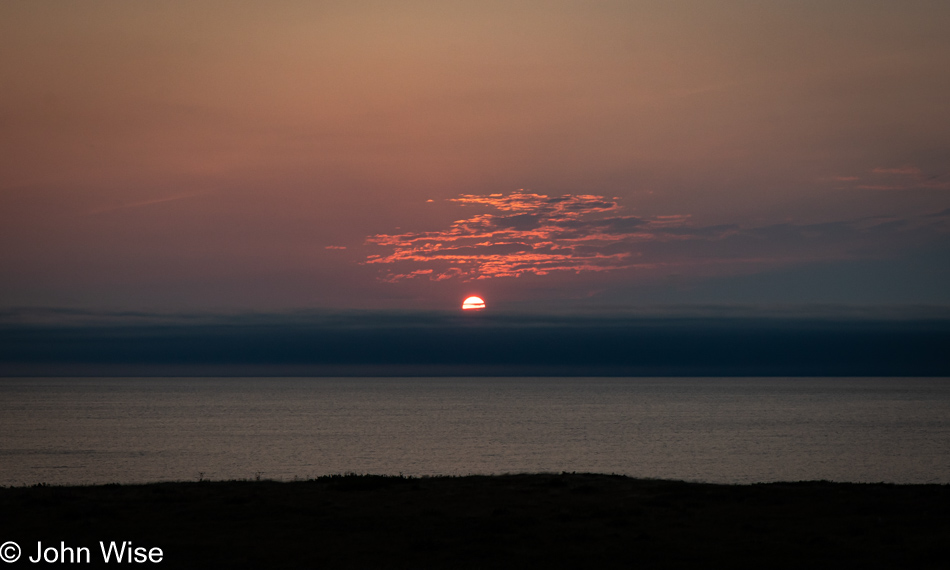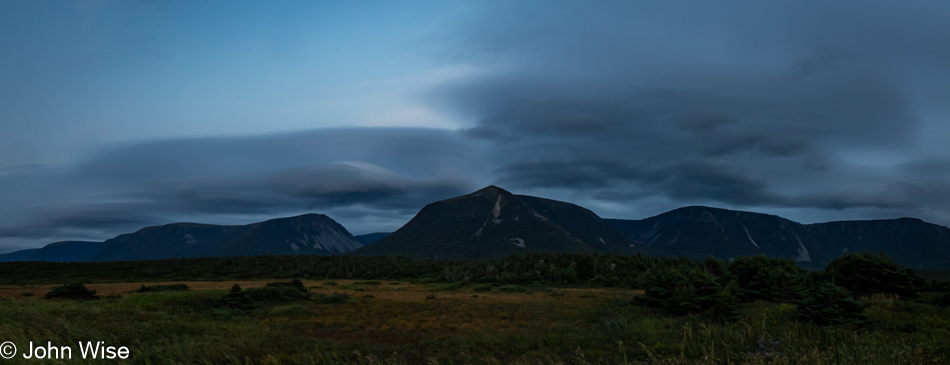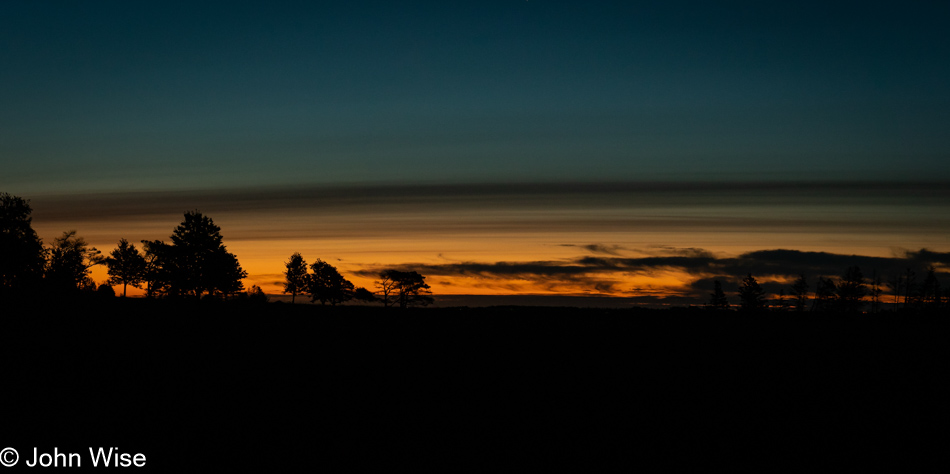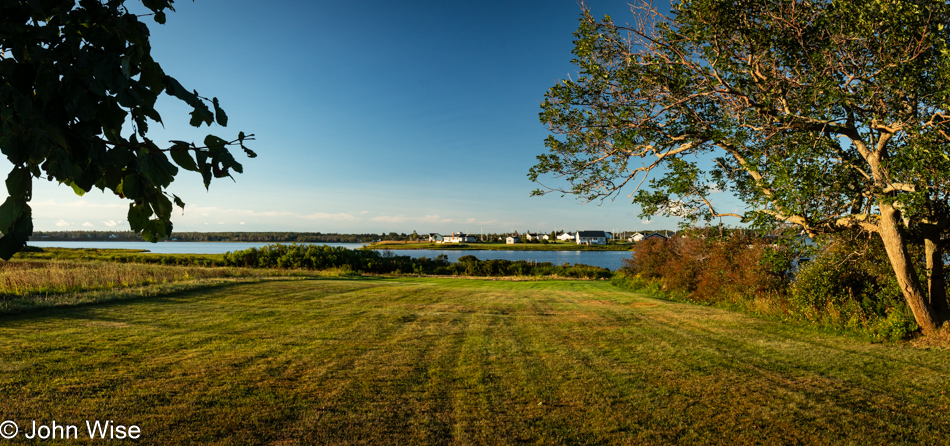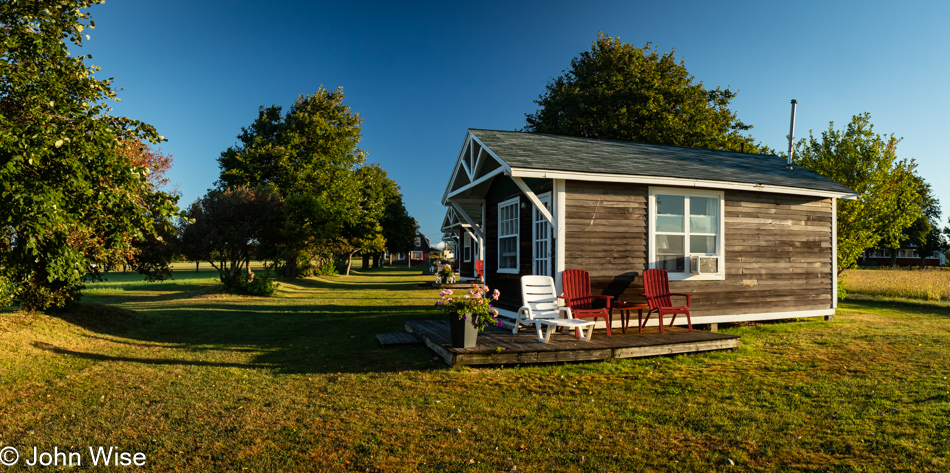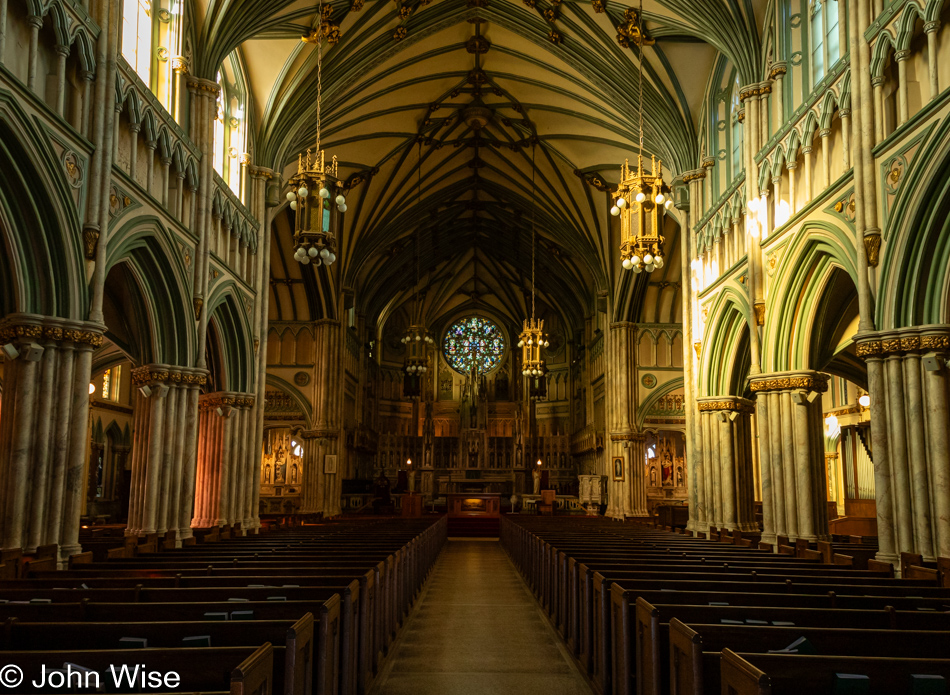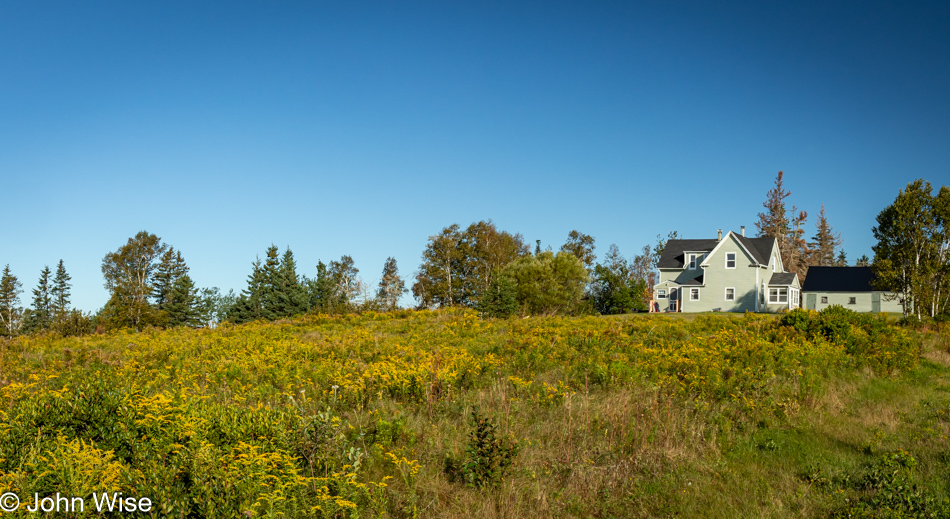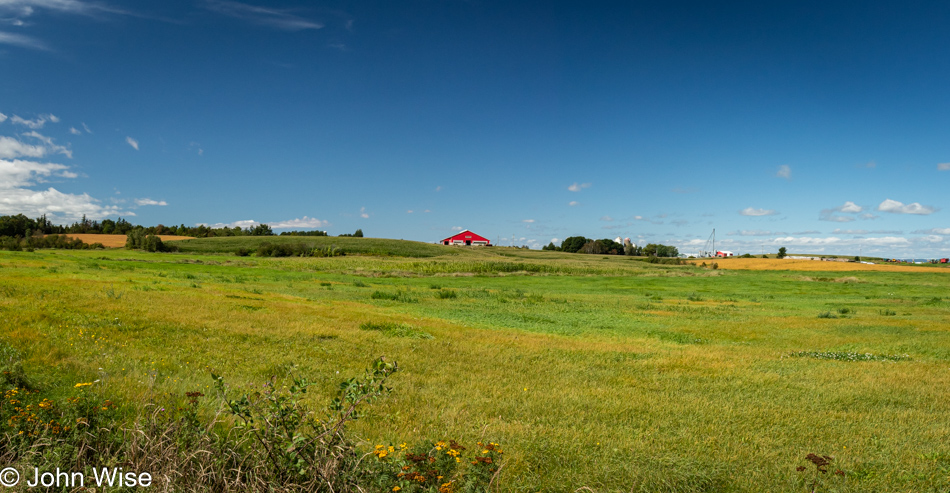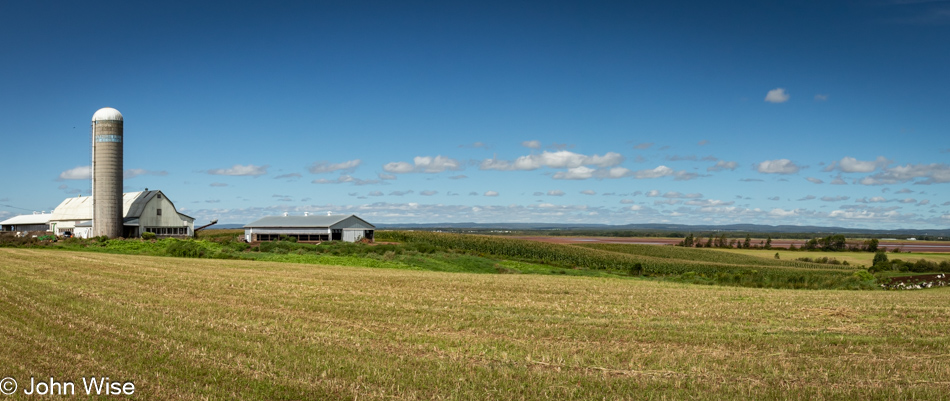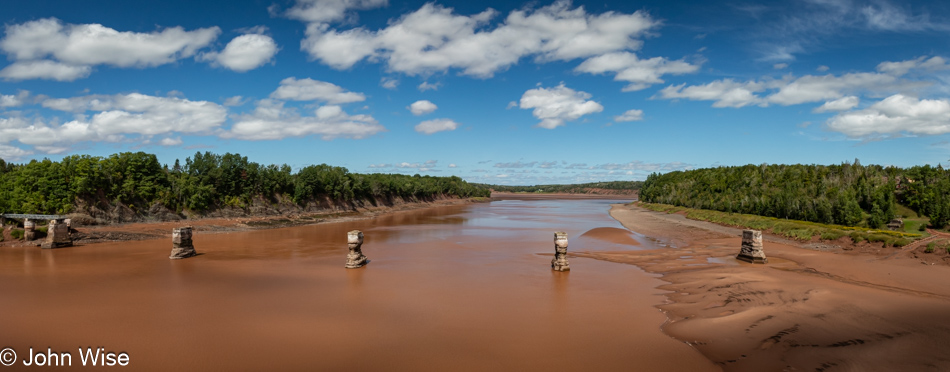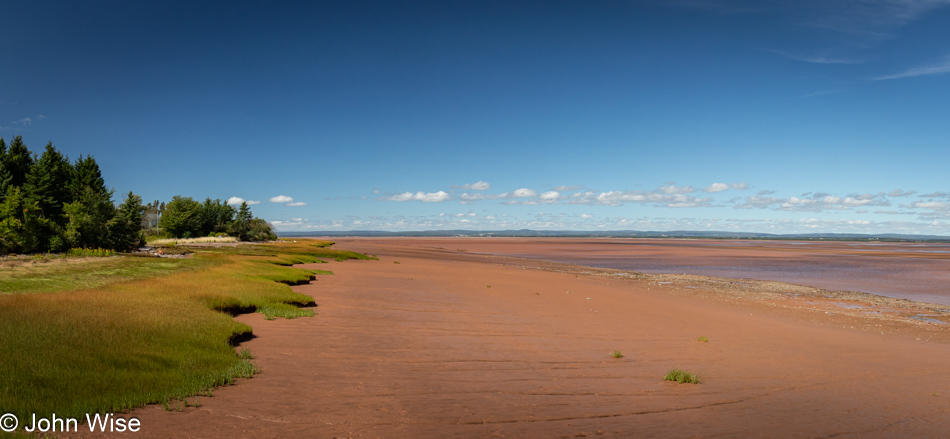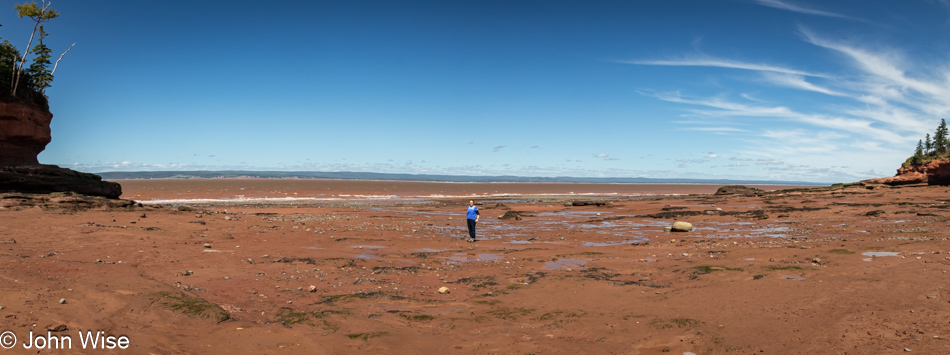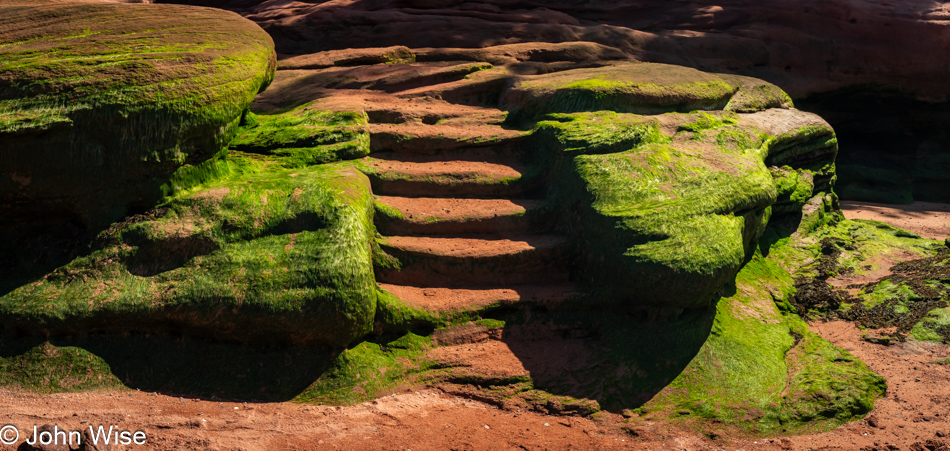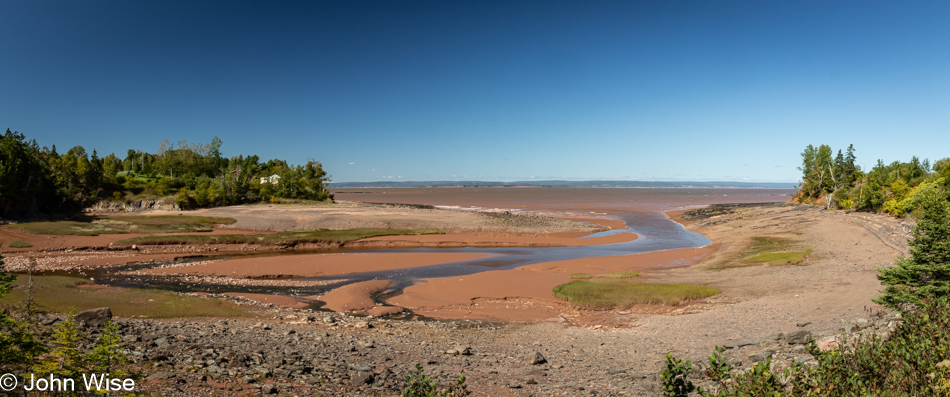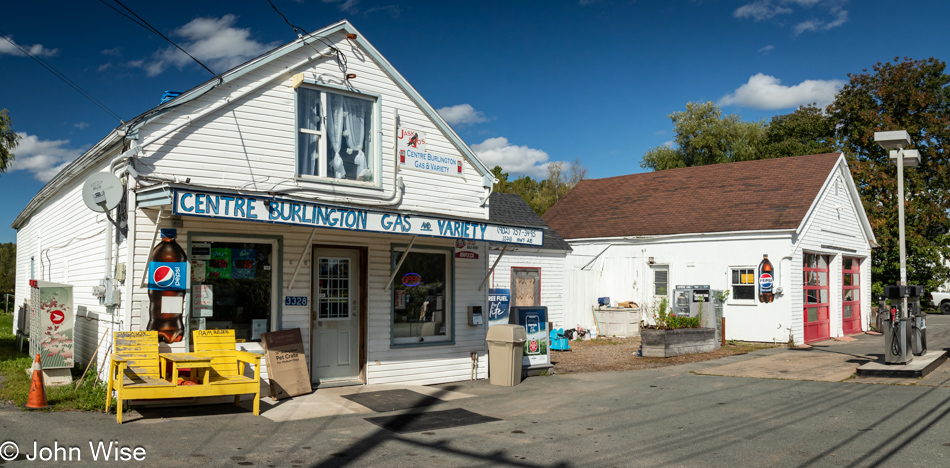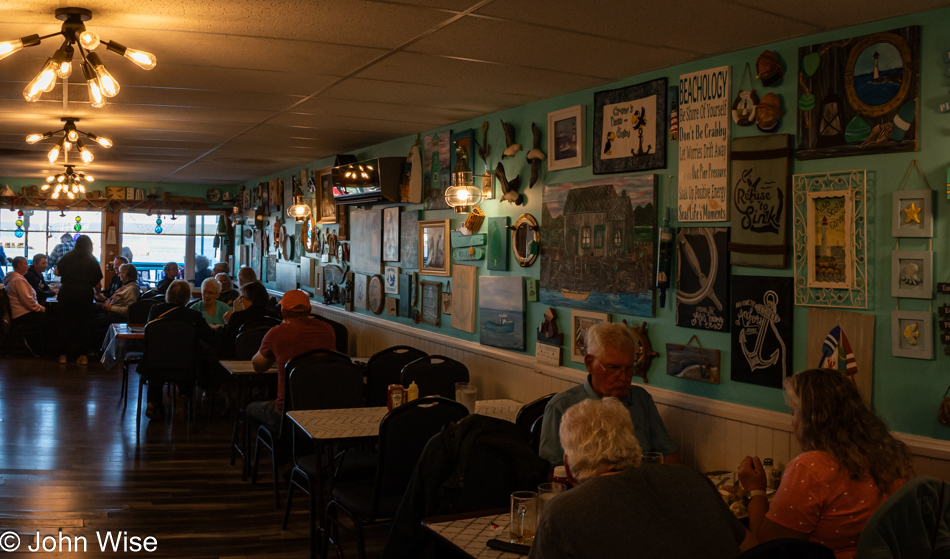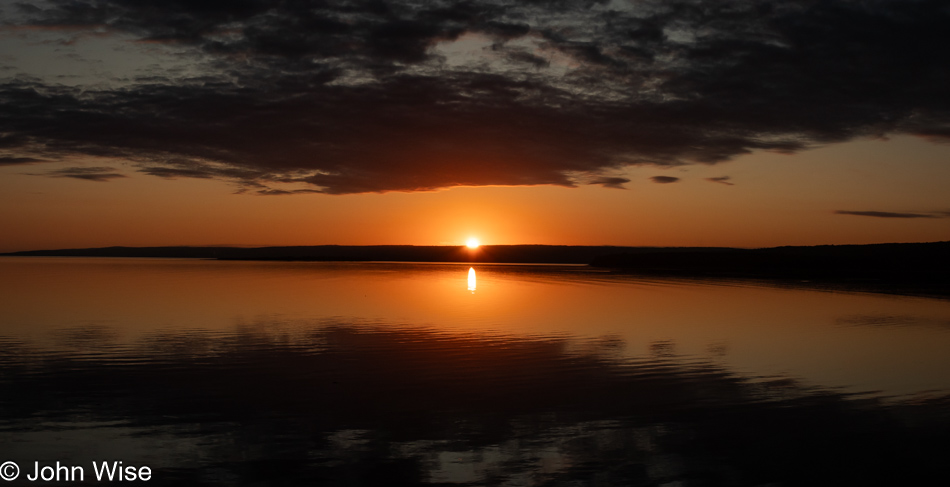
Brevity demands that I limit the number of photographs I share here each day, not that this is a hard rule. I say this because I snapped many images of this horizon while the sun was still below it, and well after it started making its way across the sky. Many of them were possibly of equal beauty, and they did record how the sky transitioned from a nearly perfectly clear view of the heavens to one where clouds began filling in quickly until the point when we finally checked out of our lodging to a heavy fog hugging the landscape and obscuring the sun.
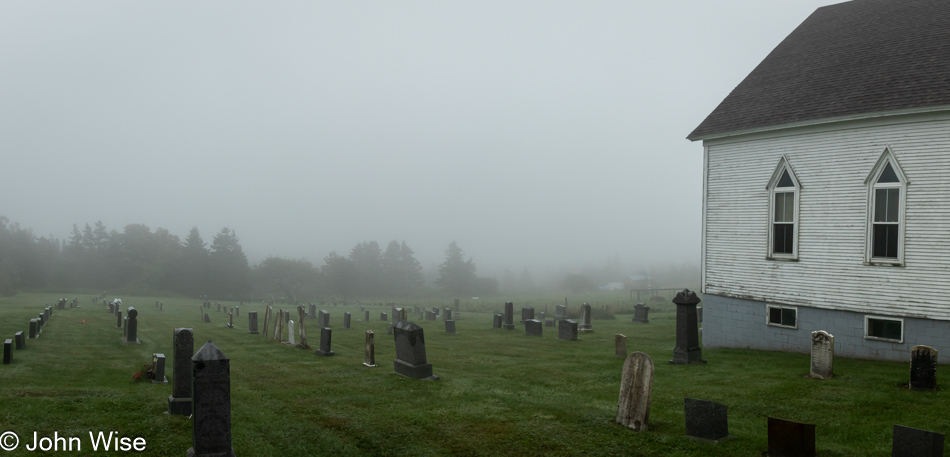
Before leaving Digby, we stopped at a Tim Horton’s for coffee and a croissant that could have passed for a hockey puck, which I’ve learned is probably not by accident. You see, Tim Hortons was founded in part by a famous hockey player who died at age 44 after crashing his car following a police chase, and while the details of this Canadian hero were suppressed for over 30 years, it appears that not only was he drunk and likely an alcoholic he also was doing various stimulants. So, this cofounder of the ubiquitous chain affectionately known as Tims and Timmys was a rather flawed man who ended up in a cemetery far too young. My point is that this crap Hortons sells is graveyard food that, whatever life it should otherwise sustain, saps my strength as I kvetch about my disappointment that, yet again, I tried this atrocious place. The only thing I can figure out about this iconic fast food joint that seems as prolific as headstones in a cemetery is Canadians being blinded by their national obsession with all things hockey. This is that homage to one of their players whose name lives on in infamy.

Blinded by my self-loathing for that stop at Timmys and maybe the dense fog, we deviated from the road that would have brought us to Yarmouth and took a turn that would bring us down the narrow strip of land known as Digby Neck to Long Island and Brier Island sandwiched between the Bay of Fundy and St. Mary’s Bay. But why would we leave a well-designed plan that was created months ago? Because along the way, something in that meticulously crafted spreadsheet got bungled, and we needed to improvise. While intently studying the map of the southern peninsula, Caroline noticed that if we traveled down the adjacent Digby Neck, we might be fortunate enough to manage two ferry crossings going south and two on our way back north. Not being one to deny my wife a couple of reasonable requests here and there, our change of plans allowed me to shake off the old man’s moss of habits and allow her to influence the day.

Our first ferry was stuck in the mud. Wouldn’t you know it, we showed up at low tide. Just kidding, we are at Sandy Cove, still on Digby Neck, and that’s obviously not a ferry.

Now, we are on a ferry for the brief crossing between the mainland and Long Island. On the rocks, with the Bay of Fundy in the background, is the Boar’s Head Lighthouse marking the entrance to Petit Passage. [Did we mention already that all of these short ferry rides were operated by the province and free of charge? – Caroline]
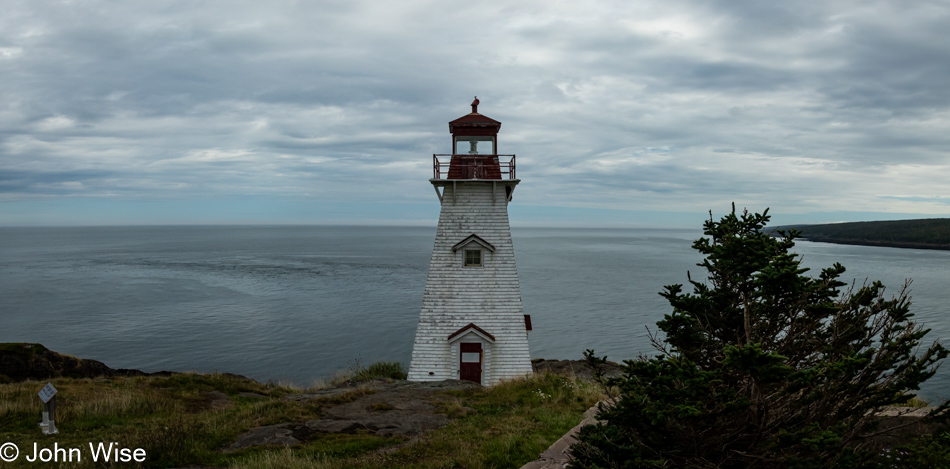
After landing in Tiverton, a right turn brought us out to the point where, for many years, these types of beacons allowed for the safe passage of ships and boats that were the backbones of the fishing industries, the movement of freight, and steady jobs for many a lightkeeper.

The fishing industries of Canada have been decimated by years of overfishing and the flaunting of the early rules to limit the practice. Broken docks, weathered buildings, and small boats littering the near shore are all signs of that past before the glory days faded.

We travel far to explore love shared among new sights while our sense of delight shines when confronted with the novelty of somewhere new. We check and recheck with each other, glancing back and forth, looking for a similar joy on the face of the person we are smiling at. After countless places our wanderings have brought us to, I can’t recall a moment when familiarity with a landscape was so well known that we failed to find surprises right before us. Had we been smart when we were younger, we could have brought walking sticks of the gnarled wood type and etched a small notch in its length, signifying a moment of enchantment. By this time, those walking sticks would have turned to sawdust and might have been replaced a dozen or more times.

We are traversing the Balancing Rock Trail south of Tiverton.

The trail has several interpretive signs, one of which points out Nova Scotia’s provincial lichen, the blue-felt lichen, but we are unable to spot even a tiny bit of it, not for lack of trying.

We scratch our senses and dig through memories. Have we ever seen these fungi in hues this verdant?

This is not blue-felt lichen; our search continues.

There’s an inclination to want to know what everything is as though that knowledge will somehow make us more familiar with the infinite differences that are immediately visible to our searching eyes and minds. Even if we knew what each species was, there is nothing to do with that information. It is the configuration of elements in contrast with each other that creates palettes of color, shapes, forms, and peculiarities that draw us in to fall into amazement at what we are seeing in this instant.

I should be quite happy that this balancing rock still stands here because I’m afraid that if this were the United States and not under constant surveillance, a young man or two would have likely tipped it over. As it was, a Christian religious fanatic must have felt they were doing god’s work by hiking out to this remote edge of a narrow island carrying a can of spray paint with him so he could deface the back of the rock with the word, ‘Repent.” Madness and zealotry are hallmarks of our modern condition, where respect for the earth’s systems in balance is not shown unless it serves the pettiness of our egos and greed. None of these negative impressions were necessary at this otherwise magnificent sight, were it not for the ugly actions of an individual treading heavily in their self-righteous arrogance.

It’s not just the balancing rock that holds appeal. The coastline here is spectacular and deserving of more time for exploration, but like the Oregon Coast we first visited more than 20 years ago and where we are still discovering new-to-us places, this discovery trip of the Maritimes will not be a complete cataloging and familiarization with the lands and seaways of New Brunswick, Nova Scotia, Prince Edward Island, and Newfoundland. The best we might accomplish is some minor curiosity satisfaction, and if we are really lucky, the attraction of it all will pull us back for a return visit. Then, during that reacquaintance, we’ll have the impossible task of choosing whether to return to places we glanced over or take the other roads to destinations we’ve ignored on this visit. Such is the dilemma of travelers taking joy in everywhere we go.

We’ve reached Freeport, the end of Long Island, and the point where we board our next ferry to Brier Island.

That’s the Peter Island Lighthouse in Westport, a lighthouse we won’t be visiting because we do not have access to a boat.

The Brier Island Lighthouse, on the other hand, will be visited, though by me more than Caroline, as she ventured off up the coast on her own. It seems she can never get enough of beach combing.

From a distance, Caroline wildly gesticulated her hands in the air with an urgency that made me hurry my lighthouse photography obsession. She’d found the tallest thicket of rose bushes with the largest rose hips she’d ever seen.

And there were these perfect rose blossoms, too.

As for me exploring the rotting seaweed at the shore, I passed, but there she was, standing in the muck, mesmerized by the tranquility of the sea and gazing into the distance with thoughts I’ll never know. If I had to guess, she’s thinking, “If there was some wind here, I could break out Happy McKiteFace for some flying right about now.”
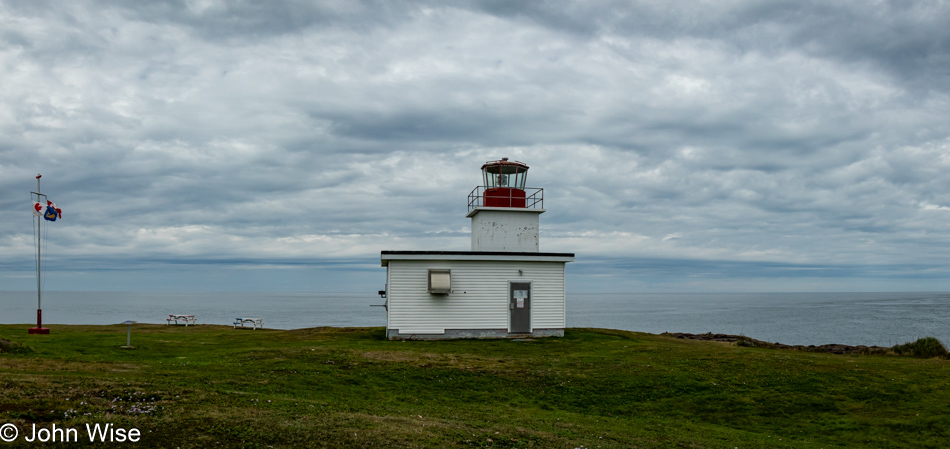
On our return, the lineup had already started for the ferry back to Long Island, but its departure was still a half hour away. Surely, we had enough time to sprint up to the Grand Passage Lighthouse for a quick peek. After our first set of ferry crossing to get here, we knew that the one farther north was timed with this one, and if that ferry was already full, we’d be in for a long wait for the next one, so we bolted. Passing nearly a dozen potential competitors on the way, we skidded into line with merely half a dozen cars ahead of us; we would be on the next ferry. Also, I grabbed lunch at the Just Above Water Cafe & Ice Cream Shop, which served up our fish and chips in record time. We believe this was the world’s best-ever two pieces of fish and fries, and it was only $16 Canadian or $12 U.S. due to the favorable exchange rate.

This is a replica made of steel of the house of folk artist Maud Lewis at a memorial park set up in her honor in Digby. The original tiny cabin was handpainted by Maud and now resides at the Arts Museum of Nova Scotia in Halifax. There’s too much to her story to do justice here in a paragraph, though Caroline might choose to embellish this when she gets her editing mitts on the post. As we drove away from this site, it dawned on us that we’d not listened to the local radio yet, tuned into the French language station on 102.3 FM that fit the moment and started creating part of the soundtrack that would be part of our memories after getting home. [We learned quite a few things about Maud Lewis on this trip, but as John said, there is a lot to convey if you’ve never heard of her. Suffice it to say, her life was tragic yet probably not unusual for a disadvantaged woman born in her time, and the tragedy part comes in full force when you look at her legacy of beautiful and uplifting folk art that was not valued enough during her lifetime. You could look her up on the Internet if you’re intrigued, and there also is a movie about her. – Caroline]

After driving southeast from the Digby area, we arrived at Kejimkujik National Park just minutes before the entry station was closing. It was nearly 5:00 p.m., and we needed at least two more hours to reach Lunenburg, where we would stay for the night. We figured we’d dip in for a single quick photo and leave. Who wants to pay a fee for but one photo that may or may not be used? After talking with Shauna, the attendant, for a good 15 minutes, we were pretty excited to venture out at least a short distance on the Mill Falls Trail and then quickly turn around.

Oh! This won’t be a jaunt to a single overlook with a fast return to the car. Nope, we are committed to reaching the falls after which the trail is named.

The lush beauty of this place is hypnotizing us. Driving through the dense forests of Nova Scotia, I don’t believe either of us considered that this type of scenery might exist on the other side of the tree line.

These are not the falls; they were yet further ahead, but getting a nice shot of them didn’t work out, so we’ll just go with this and now admit that we were in for the long haul and had decided to cross over a bridge that would take us on a loop on the other bank of the waterway.

Initially, we told ourselves that we needn’t do the entire loop, but there we were, going farther and farther until the inevitable confronted us: we were going all the way.

If you were out here and, after a day of overcast skies, the sun all of a sudden made an appearance, offering you the magic lighting of the golden hour, wouldn’t you, too, choose to stay awhile longer?

Some of these spots we had already photographed when we were on the way out, but after the sun sliced through the cloud cover, we had to take many of them all over again on our way back. Such is the price of suffering we are willing to endure to create perfect memories of perfect times in perfect places.

Lungwort lichen is still not blue-felt lichen, but we can deal with that disappointment, accepting flaws and that sights promised in the brochures might be missing. Now, as far as lungwort goes, this is indeed a capital specimen.

You had to know that if we’d found mushrooms, we’d have to share them here.

In lieu of wildlife, we present the reader (ourselves at some future date) a beautiful bunch of turkey tail mushrooms.

But John, you’ve already shared a shadowy forest floor mottled with golden sunlight, “Yeah, I know, but can one ever see too much of a good thing?”

Reflection in natural environments arises from the effortless endeavor of the natural world where still waters are found. We as humans must find quiet minds where words are allowed to spread out and capture the thoughts of an imagination that can then be put on canvas, paper, or music. This is the art that people must work for.
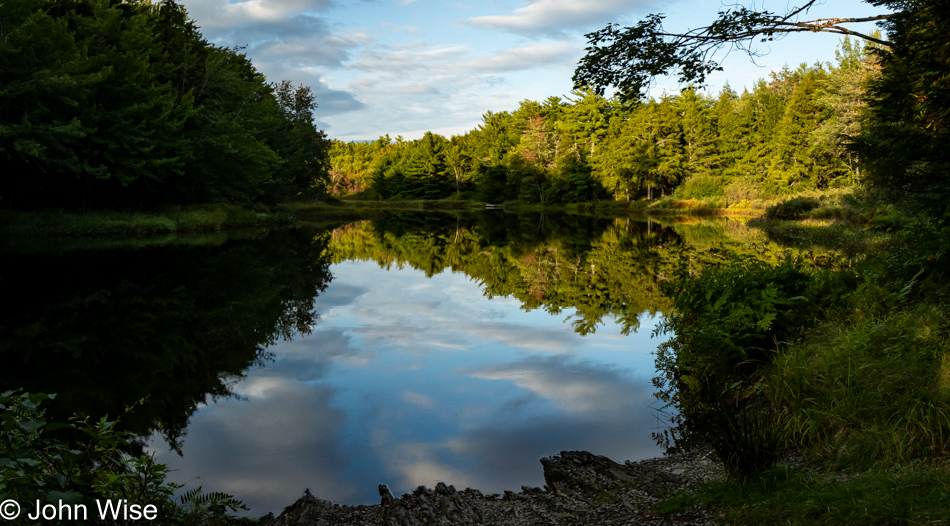
It was fully dark when we pulled into Lunenburg, Nova Scotia, whose old town is a UNESCO-designated World Heritage Site. Founded in 1753, the town was granted this status as the best example of a British colonial settlement in North America. I’d forgotten that I needed to make a reservation for dinner at the Beach Pea Kitchen here in town and pleaded with the host, explaining how I hadn’t been able to put in a reservation in May when I called as they weren’t accepting them that far out and how much I was looking forward to dining with them. They fit us in, starting Caroline with a drink called Barb’s Last Straw featuring gin, vermouth, rhubarb esprit, lemon, rosewater, egg white, and strawberry powder, while my non-alcoholic drink started with shiso shrub mixed with lemon and ginger beer. Dinner focused on a couple of gourmet fish dishes, while Caroline was also able to sample a few oysters from Sober Island north of Halifax.
What happened after dinner made for the greatest dessert we could have imagined. It arrived with a fright and a solid burst of laughter. We needed to walk off some of that heavy meal and decided to walk down to the historic dock (okay, the entire old town is historic). Meandering a nearby pier and making our way to a tall sailing ship, we saw that a gate was open, and with no signs warning about trespassing, we walked right up. It was too dark on the water to get a good photo, no matter the angle I tried shooting at. The Picton Castle, as it is known, would have to wait for morning. Walking away, just about to pass through the gate we entered, a figure from the small shack to the left sprung from the darkness, barking, “Something smells rotten in here!” The watchman instantly knew that we were fully startled, which launched him into uproarious laughter and dragged us in. With the bejeezus trying to find its way back into us, we talked with this amazingly funny guy for the next 20 minutes, thoroughly enjoying his heavy Nova Scotian accent and his continuing laughter at the whole episode. I only wish we could acknowledge this man by referring to him by his proper name, but we missed that small detail.
